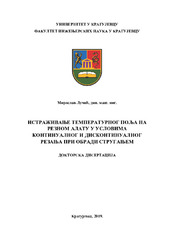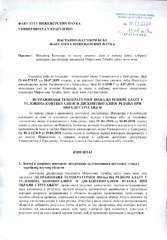Prikaz osnovnih podataka o disertaciji
Istraživanje temperaturnog polja na reznom alatu u uslovima kontinualnog i diskontinualnog rezanja pri obradi struganjem
Research on temperature field on cutting tool in the conditions of continuous and discontinuous cutting in the process of turning
| dc.contributor.advisor | Nedić, Bogdan | |
| dc.contributor.other | Erić, Milan | |
| dc.contributor.other | Radovanović, Miroslav | |
| dc.contributor.other | Mitrović, Slobodan | |
| dc.contributor.other | Baralić, Jelena | |
| dc.creator | Lučić, Miroslav | |
| dc.date.accessioned | 2020-02-26T15:44:34Z | |
| dc.date.available | 2020-02-26T15:44:34Z | |
| dc.date.available | 2020-07-03T15:13:08Z | |
| dc.date.issued | 2019-12-06 | |
| dc.identifier.uri | http://eteze.kg.ac.rs/application/showtheses?thesesId=7135 | |
| dc.identifier.uri | https://nardus.mpn.gov.rs/handle/123456789/11983 | |
| dc.identifier.uri | https://fedorakg.kg.ac.rs/fedora/get/o:1206/bdef:Content/download | |
| dc.description.abstract | Rezime: Obzirom da se mehanička energija utrošena u procesu rezanja najvećim delom transformiše u toplotnu i da nastala toplota nepovoljno utiče na alat i obradak, značajno je njeno utvrđivanje i kontrolisanje u zoni obrade. Na osnovu dosadašnjih istraživanja, najveći uticaj na izlazne karakteristike procesa obrade rezanjem uz optimalne parametre obrade ima temperatura u zoni rezanja. Temperatura u zoni rezanja na koju parametri režima obrade bitno utiču je veoma važan pokazatelj procesa obrade rezanjem i može se koristiti kao kriterijum optimizacije procesa. Veliki specifični pritisci i visoka temperatura u uskoj zoni rezanja imaju za posledicu pad tvrdoće alatnog materijala, što se odražava na gubljenje reznih sposobnosti i otkaz alata. Zbog toga je poznavanje vrednosti rasporeda temperature u alatu od izuzetnog značaja, stim što sa praktične tačke gledišta najvažnije je poznavanje maksimalne temperature zagrevanja površine reznog alata. Doktorska disertacija „Istraživanje temperaturnog polja u reznom alatu u uslovima kontinualnog i diskontinualnog rezanja pri obradi struganjem“ obuhvata analitičko-eksperimentalna istraživanja i razvoj numeričkog modela u uslovima kontinualnog i diskontinualnog rezanja, kako bi se utvrdila raspodela temperature u kontaktu alat/strugotina sa ciljem utvrđivanja i predviđanja njene vrednosti na grudnoj površini alata. Polazne osnove disertacije su bazirane na tome da je moguće kreirati numerički model za simulacije temperaturnih polja na reznom alatu metodom konačnih elemenata verifikovan na osnovu rezultata dobijenih odgovarajućim eksperimentalnim merenjima. Cilj doktorske disertacije je da se učine pomaci u pravcu razvoja numeričkih modela za proračun temperatura u uslovima kontinualnog rezanja (struganje punog materijala) i diskontinualnog rezanja (struganje uzdužnih i poprečnih žlebova) na okruglom obratku bez primene sredstava za hlađenje i podmazivanje. Osnova svih aktivnosti koje su sastavni deo doktorata je poređenje temperatura u alatu dobijenih eksperimentalnim merenjima i numeričkom simulacijom metodom konačnih elemenata za isti režim rezanja u uslovima kontinualne i diskontinualne obrade. Pri istraživanju temperaturnih polja i temperatura u definisanom alatu pri kontinualnom i diskontinualnom struganju su primenjene: - analitičko-eksperimentalne metode i - simulacije metodom konačnih elemenata, sa poređenjem eksperimentalnih i numeričkih rezultata i njihovom analizom. Analitičke metode se zasnivaju na statističkoj obradi rezultata eksperimentalnih merenja pri čemu se određuju vrednosti konstanti i eksponenata eksponencijalnog matematičkog modela za temperature na grudnoj površini alata. Analizirani su i koeficijenti korelacije za sve modele kao i vrednosti za signifikantnost svih parametara u modelima. | sr |
| dc.description.abstract | Summary: Since the mechanical energy used in the process of cutting is mainly transformed into thermal energy and since produced thermal energy has negative effects on the tool itself and its work piece, it is significant to establish it and control it within the processing zone. According to latest research, the temperature within the cutting zone has the greatest influence on the output characteristics of the process of machining with optimal parameters of processing. The temperature within the zone of cutting on which the parameters of machining regime have significant influence is a very important indicator of the process of cutting and can be used as a criterion of the process optimization. Large specific pressure and high temperature within the narrow zone of cutting have as a consequence the tool hardness decrease, which results in lessening cutting tool abilities and its failure. Therefore, the knowledge of values of temperature distribution in the tool is of great importance, where from the practical point of view, the most important temperature is the maximum heating tool temperature. PhD dissertation "Research on temperature field on cutting tool in the conditions of continuous and discontinuous cutting in the process of turning" includes analytical and experimental research and developmentof numerical model in the conditions of continuous and discontinuous cutting, in order to assess the distribution of temperature at the contact tool/chips so as to establish its values on the toolface. The starting points of the dissertation are based on the possibility of creating numerical model for simulations of temperature fields on cutting tool by the finite element method which is researched by using the results acquired by appropriate experimental measurement. The aim of PhD dissertation is to make progress in the course of development of numerical models for calculating temperatures in the conditions of continuous cutting (turning hard materials) and discontinuous cutting(turning longitudinal and transversal grooves )on the round working piece without using cooling agents and lubricants). The basis of all activities which are the integral part of the dissertation is the comparison of temeperatures in the tool acquired by experimental measurement and numerical simulation using the finite element method for the same cutting regime in the conditions of continuous and discontinuous processing. When researching temperature fields and temeperatures in the defined tool during continuous and discontinuous turning the following methods were applied: - analytical and experimental and - simulation by using the finite element method, with comparison of experimental and analytical results and their analysis. Analytical methods are about statistical processing of the results of experimental measurements where the values of parameters of the exponential mathematical model for temperatures on the toolface were acquired. Coorelation coefficients for all models, as well as values for significance of all parameters in models were analysed. | en |
| dc.format | application/pdf | |
| dc.language | sr | |
| dc.publisher | Универзитет у Крагујевцу, Факултет инжењерских наука | sr |
| dc.relation | info:eu-repo/grantAgreement/MESTD/Technological Development (TD or TR)/35034/RS// | |
| dc.rights | openAccess | en |
| dc.rights.uri | https://creativecommons.org/licenses/by/4.0/ | |
| dc.source | Универзитет у Крагујевцу | sr |
| dc.subject | kontinualno i diskontinualno struganje | sr |
| dc.subject | continuous and discontinuous turning | en |
| dc.subject | rezni alat | sr |
| dc.subject | kontakt alat/strugotina | sr |
| dc.subject | temperatursko polje | sr |
| dc.subject | temperatura | sr |
| dc.subject | eksperimentalno istraživanje | sr |
| dc.subject | numerička analiza | sr |
| dc.subject | metoda konačnih elemenata (MKE) | sr |
| dc.subject | cutting tool | en |
| dc.subject | contact tool/chips | en |
| dc.subject | temperature field | en |
| dc.subject | temperature | en |
| dc.subject | experimental research | en |
| dc.subject | numerical analysis | en |
| dc.subject | finite element method (FEM) | en |
| dc.title | Istraživanje temperaturnog polja na reznom alatu u uslovima kontinualnog i diskontinualnog rezanja pri obradi struganjem | sr |
| dc.title.alternative | Research on temperature field on cutting tool in the conditions of continuous and discontinuous cutting in the process of turning | en |
| dc.type | doctoralThesis | en |
| dc.rights.license | BY | |
| dc.identifier.fulltext | http://nardus.mpn.gov.rs/bitstream/id/48281/Disertacija.pdf | |
| dc.identifier.fulltext | http://nardus.mpn.gov.rs/bitstream/id/48282/Miroslav_Lucic_FIN.pdf | |
| dc.identifier.fulltext | https://nardus.mpn.gov.rs/bitstream/id/48282/Miroslav_Lucic_FIN.pdf | |
| dc.identifier.fulltext | https://nardus.mpn.gov.rs/bitstream/id/48281/Disertacija.pdf | |
| dc.identifier.rcub | https://hdl.handle.net/21.15107/rcub_nardus_11983 |



